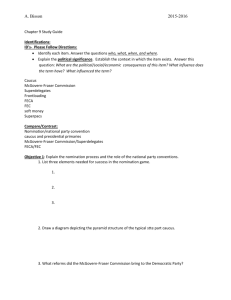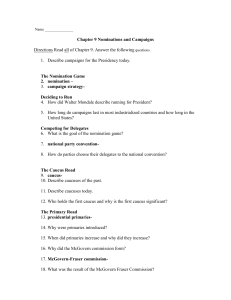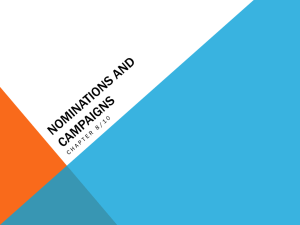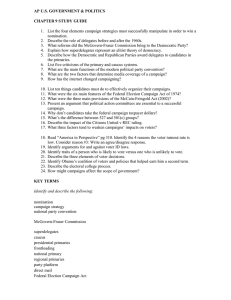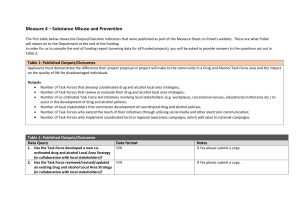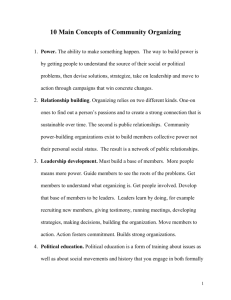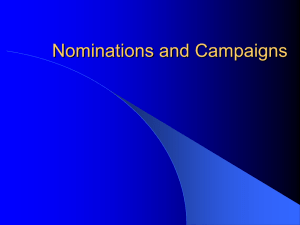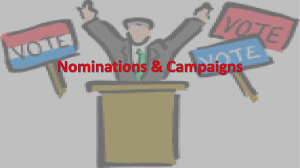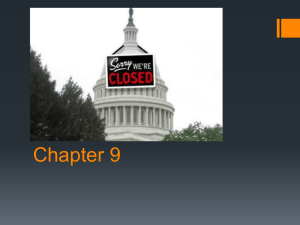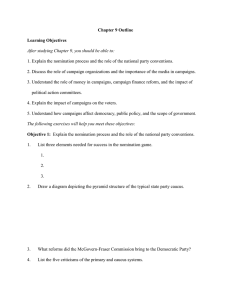Chapter 9: Nominations & Campaigns
advertisement
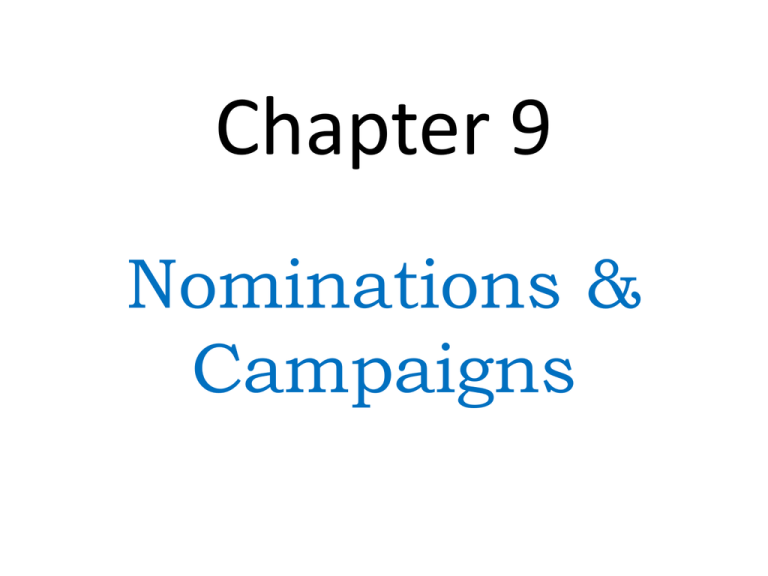
Chapter 9 Nominations & Campaigns Nomination • Party’s official endorsement of a candidate for office Success money + media attention + momentum Campaign Strategy: way that candidates attempt to manipulate each of these elements in order to achieve nomination • In most developed nations, campaigns last 2 months or less … • In the U.S., Presidential campaigns can be between 1 & 2 years. • Goal of nomination is to win the support of the majority of delegates at the National Party Convention • 1830s to 1960s: delegates were composed of political elites and chosen by state party “bosses” • 1968 Democratic Party convention: Issue of Vietnam war split party between pro-war delegates and anti-war party members; police clashes with protesters outside convention hall. McGovern-Fraser Commission • Concession won by anti-war protestors to examine delegate selection process • Recommendation to open selection of delegates via primary elections and/or caucuses • Changes, enforced by state laws, extended to Republican Party, as well. But … • Populist primaries/caucuses balanced by elitist Superdelegates – Officeholders/party members chosen by the national party – 2008: 16% of Dems, 6% of Reps Caucus • Open meetings to determine delgate selection • Currently about 12 states, mostly rural. Iowa most prominent (as it’s the first state contest). • Take 1-4 hours to complete resulting in lower turnout. Primary • Voters go to polls • New Hampshire most prominent (1st) FRONTLOADING • States holding contests early in the ‘season’ to capitalize ion attention and money. • About 2/3 of the delegates chosen within 6 weeks of the first caucus (Iowa) • Early states benefit from media attention, money, issues on the agenda • Generates “the big mo” = momentum – Media coverage, donations, support, etc. Analysis of Primary Process • • • • • Early states receive large amounts of attention Difficult for incumbents Money plays “too big” a role Participation is low Media has “too much” power Media Coverage • 2 forms: – From campaign’s media budget (~1/2 TV) – “Free” attention as newsmakers • Most media coverage of candidates and campaigns is superficial, covering events of the day: where the candidate went, the size of the crowds, etc. & “Horserace Journalism”: covering public opinion polls PARTY PLATFORM • Statement of goals and policies for the next four years • Drafted prior to the beginning of the convention(s) DIRECT MAIL • Method of raising money via sending requests to lists of people who have supported similar issues/candidates in the past • Value of lists and Internet FEDERAL ELECTION CAMPAIGN ACT • Created 1974 • Meant to reform campaign financing • Created Federal Election Commission (enforces finance laws) • Established guidelines for campaign financing Buckley v. Valeo (1976) • Challenged FECA • Struck down the limitation on the amount that individuals could donate to their own campaigns • Issue: Free Speech SOFT MONEY • Contributions intended to be used for partybuilding expenses or generic advertising • Another loophole to FECA limits • Banned by McCain-Feingold Act of 2002 Citizens United v. Federal Election Commission, (2010) • McCain-Feingold Act declared an unconstitutional restriction of free speech • Corporations and unions can spend unlimited amounts to promote their political views as long as they don’t coordinate with a candidate’s campaign Political Action Committees • ‘PACs’ • Interest groups can form PACs in order to directly channel larger contributions to campaigns than allowed by individuals
